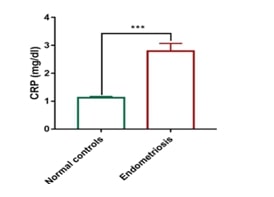Retrospective Analysis of CRP and Complement 3 Levels in Endometriosis Patients: Insights from ELISA Assessments

Abstract:
Endometriosis refers to the existence of functional endometrial glands and tissue in locations beyond the uterus. This condition frequently leads to persistent pelvic discomfort, occasionally severe, and inflammation is recognized as a contributing factor in the development of endometriosis. Finding a non-invasive indicator for endometriosis would greatly assist in its early detection and treatment. Therefore, the present study was conducted to study the levels of inflammatory mediators - Complement 3 (C3) and C-reactive protein (CRP) in endometriosis condition. The study was conducted in 40 women who have been laparoscopically diagnosed with endometriosis, and the levels of C3 and serum CRP were estimated in the plasma by ELISA analysis. The results demonstrated significant rise in the levels of serum CRP and C3 in endometriotic women as compared to the levels in non-endometriotic women. Due to the altered regulation of the complement system and the effects of pelvic adhesions and deep infiltrating endometriosis, there is a significant rise in the levels of complement 3 and serum CRP respectively. While immune infiltration and constant inflammatory milieu foster the disease, the biggest pathological consequences arise from aberrant complement activation. Hence, with the aid of pre-clinical and clinical trials, a detailed strategy can be formulated to suppress complement activation and alleviate the devastating effects of endometriosis.
References:
[1]. Giudice, L.C., 2004. kao LC. Endometriosis. Lancet, 364(9447), pp.1789-99.
[2]. Thubert, T., Santulli, P., Marcellin, L., Menard, S., M'Baye, M., Streuli, I., Borghese, B., de Ziegler, D. and Chapron, C., 2014. Measurement of hs-CRP is irrelevant to diagnose and stage endometriosis: prospective study of 834 patients. American Journal of Obstetrics and Gynecology, 210(6), pp.533-e1.
[3]. Abrão, M.S., Podgaec, S., Filho, B.M., Ramos, L.O., Pinotti, J.A. and de Oliveira, R.M., 1997. The use of biochemical markers in the diagnosis of pelvic endometriosis. Human Reproduction, 12(11), pp.2523-2527.
[4]. Wu, M.H., Hsiao, K.Y. and Tsai, S.J., 2015. Endometriosis and possible inflammation markers. Gynecology and minimally invasive therapy, 4(3), pp.61-67.
[5]. Mu, F., Harris, H.R., Rich-Edwards, J.W., Hankinson, S.E., Rimm, E.B., Spiegelman, D. and Missmer, S.A., 2018. A prospective study of inflammatory markers and risk of endometriosis. American journal of epidemiology, 187(3), pp.515-522.
[6]. Kokot, I., Piwowar, A., Jędryka, M., Sołkiewicz, K. and Kratz, E.M., 2021. Diagnostic significance of selected serum inflammatory markers in women with advanced endometriosis. International journal of molecular sciences, 22(5), p.2295.
[7]. Pepys, M.B. and Hirschfield, G.M., 2003. C-reactive protein: a critical update. The Journal of clinical investigation, 111(12), pp.1805-1812.
[8]. Abrão, M.S., Podgaec, S., Filho, B.M., Ramos, L.O., Pinotti, J.A. and de Oliveira, R.M., 1997. The use of biochemical markers in the diagnosis of pelvic endometriosis. Human Reproduction, 12(11), pp.2523-2527.
[9]. Matarese, G., Alviggi, C., Sanna, V., Howard, J.K., Lord, G.M., Carravetta, C., Fontana, S., Lechler, R.I., Bloom, S.R. and De Placido, G., 2000. Increased leptin levels in serum and peritoneal fluid of patients with pelvic endometriosis. The Journal of Clinical Endocrinology & Metabolism, 85(7), pp.2483-2487.
[10]. Xavier, P., Belo, L., Beires, J., Rebelo, I., Martinez-de-Oliveira, J., Lunet, N. and Barros, H., 2006. Serum levels of VEGF and TNF-α and their association with C-reactive protein in patients with endometriosis. Archives of gynecology and obstetrics, 273, pp.227-231.
[11]. Kianpour, M., Nematbakhsh, M. and Ahmadi, S.M., 2012. C-reactive protein of serum and peritoneal fluid in endometriosis. Iranian journal of nursing and midwifery research, 17(2 Suppl1), pp.S115-S119.
[12]. Bahari, H., Zeraattalab-Motlagh, S., Sajadi Hezaveh, Z., Namkhah, Z., Golafrouz, H., Taheri, S. and Sahebkar, A., 2024. The Effects of Sumac Consumption on Inflammatory and Oxidative Stress Factors: A Systematic Review of Randomized Clinical Trials. Current Pharmaceutical Design, 30(27), pp.2142-2151.
[13]. Rekker, K., Saare, M., Eriste, E., Tasa, T., Kukuškina, V., Roost, A.M., Anderson, K., Samuel, K., Karro, H., Salumets, A. and Peters, M., 2017. High-throughput mRNA sequencing of stromal cells from endometriomas and endometrium. Reproduction, 154(1), pp.93-100.
[14]. Suryawanshi, S., Huang, X., Elishaev, E., Budiu, R.A., Zhang, L., Kim, S., Donnellan, N., Mantia-Smaldone, G., Ma, T., Tseng, G. and Lee, T., 2014. Complement pathway is frequently altered in endometriosis and endometriosis-associated ovarian cancer. Clinical Cancer Research, 20(23), pp.6163-6174.
[15]. Ahn, S.H., Khalaj, K., Young, S.L., Lessey, B.A., Koti, M. and Tayade, C., 2016. Immune-inflammation gene signatures in endometriosis patients. Fertility and sterility, 106(6), pp.1420-1431.
[16]. Babah, O.A., Ojewunmi, O.O., Onwuamah, C.K., Udenze, I.C., Osuntoki, A.A. and Afolabi, B.B., 2023. Serum concentrations of IL-16 and its genetic polymorphism rs4778889 affect the susceptibility and severity of endometriosis in Nigerian women. BMC Women's Health, 23(1), p.253.
[17]. Bakhashab, S., Banafea, G.H., Ahmed, F., Alsolami, R., Schulten, H.J., Gauthaman, K., Naseer, M.I. and Pushparaj, P.N., 2024. Acute and prolonged effects of interleukin-33 on cytokines in human cord blood-derived mast cells. Immunology Letters, 269, p.106908.
[18]. Tehrani, S.D., Hosseini, A., Shahzamani, M., Heidari, Z., Askari, G., Majeed, M., Sahebkar, A. and Bagherniya, M., 2024. Evaluation of the effectiveness of curcumin and piperine co-supplementation on inflammatory factors, cardiac biomarkers, atrial fibrillation, and clinical outcomes after coronary artery bypass graft surgery. Clinical Nutrition ESPEN, 62, pp.57-65.
[19]. Vodolazkaia, A., Bossuyt, X., Fassbender, A., Kyama, C.M., Meuleman, C., Peeraer, K., Tomassetti, C. and D'Hooghe, T.M., 2011. A high sensitivity assay is more accurate than a classical assay for the measurement of plasma CRP levels in endometriosis. Reproductive Biology and Endocrinology, 9, pp.1-9.
[20]. Ruiz, L.A., Dutil, J., Ruiz, A., Fourquet, J., Abac, S., Laboy, J. and Flores, I., 2011. Single-nucleotide polymorphisms in the lysyl oxidase-like protein 4 and complement component 3 genes are associated with increased risk for endometriosis and endometriosis-associated infertility. Fertility and sterility, 96(2), pp.512-515.

